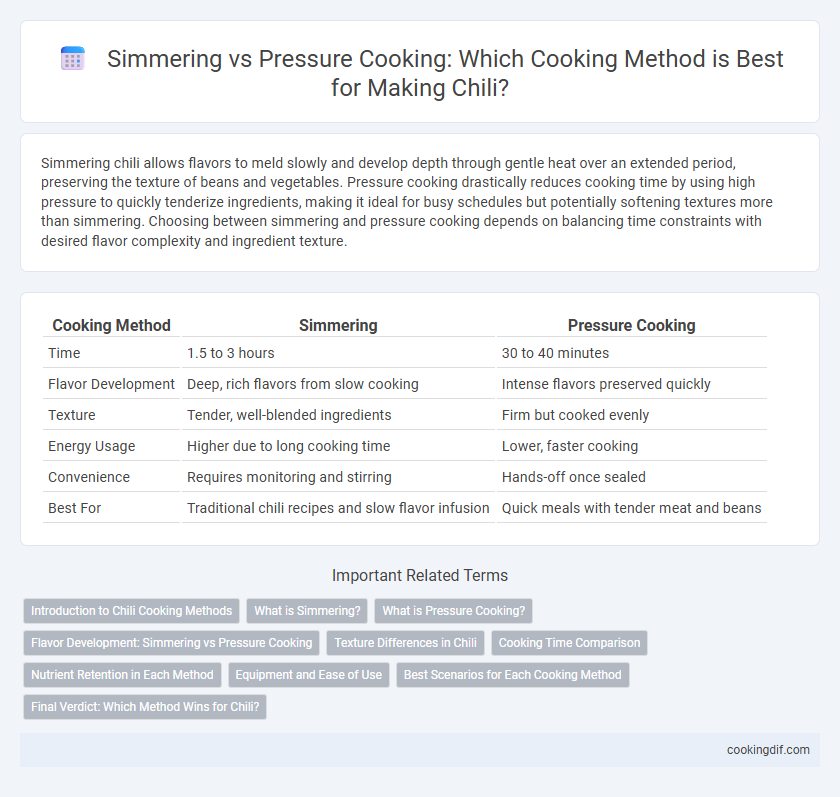Simmering chili allows flavors to meld slowly and develop depth through gentle heat over an extended period, preserving the texture of beans and vegetables. Pressure cooking drastically reduces cooking time by using high pressure to quickly tenderize ingredients, making it ideal for busy schedules but potentially softening textures more than simmering. Choosing between simmering and pressure cooking depends on balancing time constraints with desired flavor complexity and ingredient texture.
Table of Comparison
| Cooking Method | Simmering | Pressure Cooking |
|---|---|---|
| Time | 1.5 to 3 hours | 30 to 40 minutes |
| Flavor Development | Deep, rich flavors from slow cooking | Intense flavors preserved quickly |
| Texture | Tender, well-blended ingredients | Firm but cooked evenly |
| Energy Usage | Higher due to long cooking time | Lower, faster cooking |
| Convenience | Requires monitoring and stirring | Hands-off once sealed |
| Best For | Traditional chili recipes and slow flavor infusion | Quick meals with tender meat and beans |
Introduction to Chili Cooking Methods
Simmering chili allows flavors to develop gradually through low, steady heat, enhancing the depth and richness of the dish over time. Pressure cooking significantly reduces cooking time by using high pressure to quickly tenderize meats and meld spices, making it ideal for busy cooks seeking a hearty meal. Each method affects texture and flavor intensity differently, offering versatile options depending on desired cooking duration and taste profile.
What is Simmering?
Simmering is a cooking method where chili is cooked gently at a temperature just below boiling, typically between 185degF and 205degF (85degC to 96degC). This technique allows flavors to meld slowly, resulting in tender meat and a rich, well-developed sauce. Simmering maintains a steady, low heat that prevents the chili from burning or becoming tough.
What is Pressure Cooking?
Pressure cooking uses sealed pots to trap steam, significantly raising the boiling point of water and reducing cooking times for chili. This method enhances flavor infusion by maintaining high pressure and temperature, which tenderizes tougher cuts of meat and melds spices quickly. Simmering, in contrast, involves cooking chili at lower temperatures over longer periods, allowing gradual flavor development but requiring more time.
Flavor Development: Simmering vs Pressure Cooking
Simmering chili allows gradual flavor development by slowly melding spices, meats, and beans, enhancing depth and complexity through extended cooking time. Pressure cooking drastically reduces cooking time but may produce less nuanced flavors due to rapid heat exposure and limited evaporation. Choosing simmering promotes richer, layered taste profiles, while pressure cooking favors convenience with moderately infused flavors.
Texture Differences in Chili
Simmering chili allows flavors to meld slowly, resulting in tender meat and a thick, hearty texture as collagen breaks down gradually. Pressure cooking dramatically reduces cooking time while tenderizing tougher cuts of meat quickly, but it can lead to a slightly less textured, more uniform chili. The choice between simmering and pressure cooking affects the chili's mouthfeel, with simmering offering a more complex, rich texture compared to the softer consistency from pressure cooking.
Cooking Time Comparison
Simmering chili typically requires 1.5 to 3 hours to develop rich flavors and tenderize meat, allowing gradual infusion of spices and ingredients. Pressure cooking significantly reduces this time to 25-40 minutes by utilizing high steam pressure, breaking down tough cuts rapidly while preserving nutrients. This contrast in cooking time highlights pressure cooking as a more efficient method for quick chili preparation without sacrificing depth of flavor.
Nutrient Retention in Each Method
Simmering chili allows gentle heat application, preserving water-soluble vitamins like vitamin C and B-complex, though prolonged exposure may cause some nutrient loss. Pressure cooking significantly reduces cooking time, which helps retain heat-sensitive nutrients and antioxidants by limiting oxidative damage. Both methods impact nutrient retention differently, with pressure cooking generally preserving more nutrients due to shorter cooking durations compared to simmering.
Equipment and Ease of Use
Simmering chili requires a heavy-bottomed pot or Dutch oven that maintains steady low heat, allowing flavors to meld gradually without burning. Pressure cooking demands a sealed pressure cooker or Instant Pot, which cooks chili quickly by raising the boiling point of water, significantly reducing cooking time. While simmering offers precise temperature control for delicate ingredients, pressure cookers provide convenience and efficiency, making them ideal for busy cooks.
Best Scenarios for Each Cooking Method
Simmering chili allows flavors to meld slowly, making it ideal for recipes needing tender meat and well-developed spice profiles over extended cooking times. Pressure cooking accelerates the process, perfect for quick meals or when using tougher cuts of meat, ensuring tender results in under an hour. Each method suits different time constraints and flavor intensities, with simmering favored for depth and pressure cooking for speed.
Final Verdict: Which Method Wins for Chili?
Pressure cooking wins for chili by significantly reducing cooking time while enhancing flavor infusion and tenderness of meat compared to simmering. Simmering offers gradual flavor development but requires hours, making it less practical for quick meals. For optimal chili texture and rich taste with efficiency, pressure cooking is the superior method.
Simmering vs pressure cooking for cooking method Infographic

 cookingdif.com
cookingdif.com